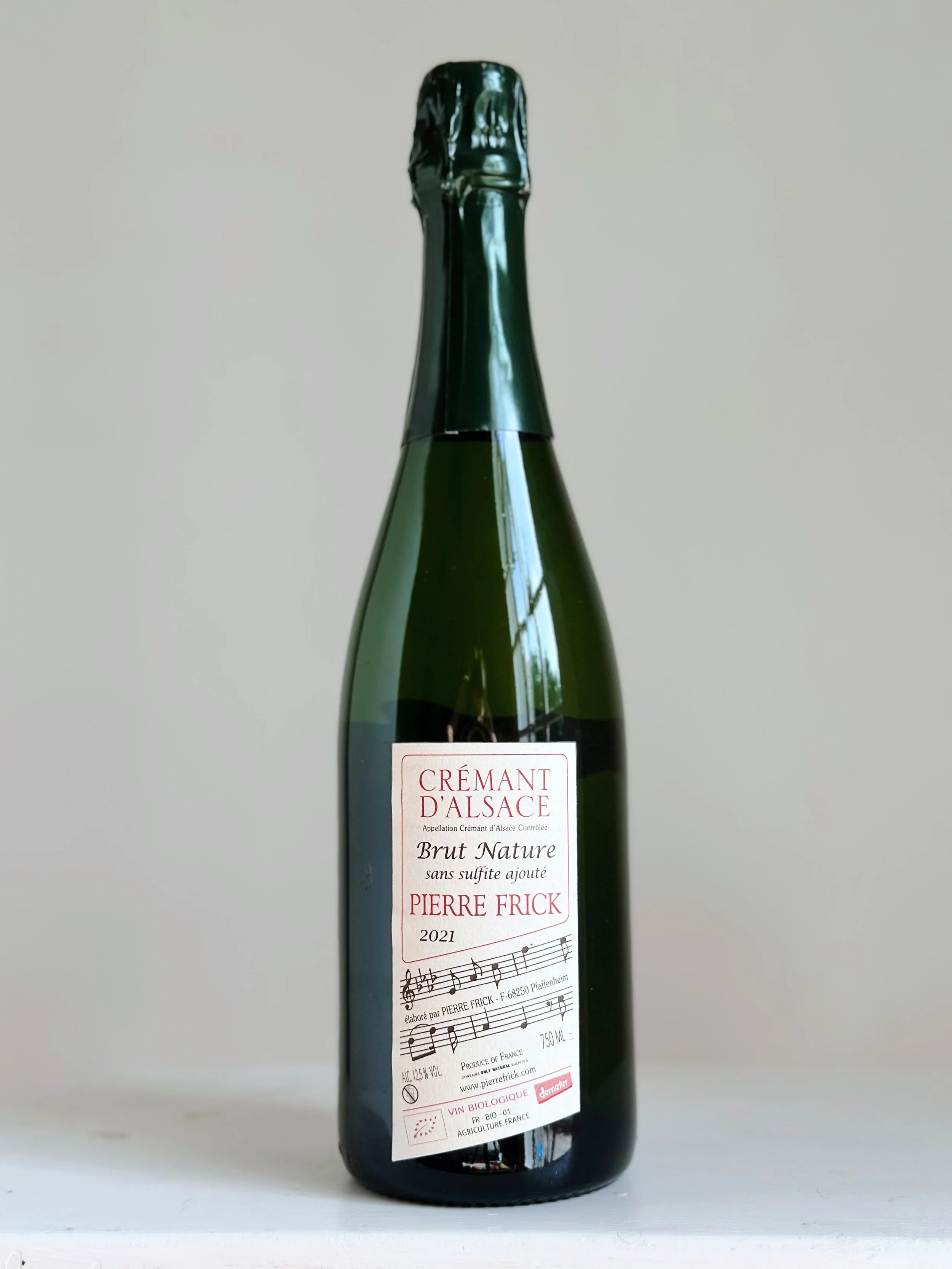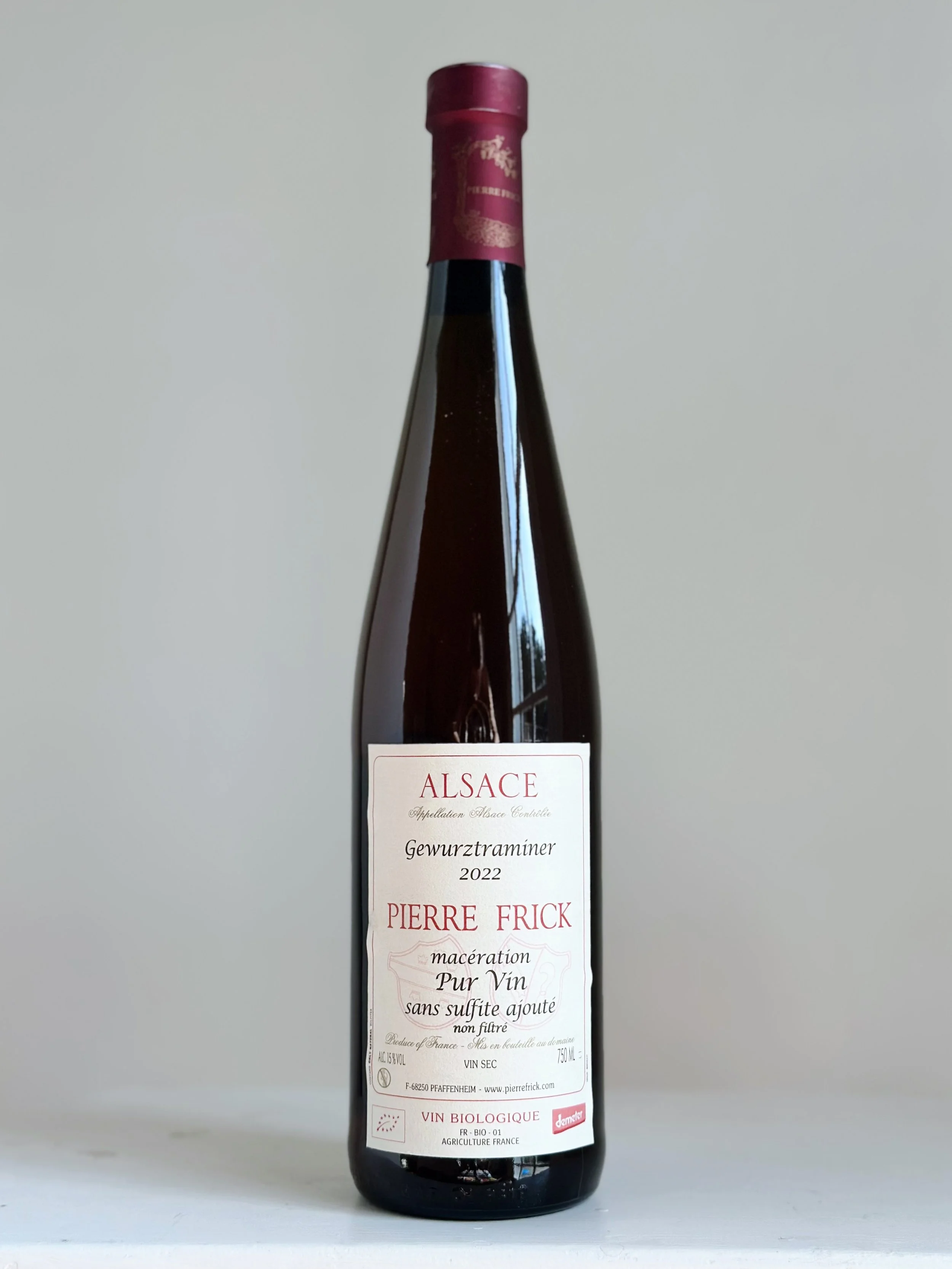Pierre Frick needs no introduction. Icons of the natural wine world and pioneers of the modern age of biodynamic farming, the Frick family has been cultivating grapevines in Alsace for 12 generations. Now in the hands of Jean-Pierre and Chantal Frick, their meticulous and philosophical approach yields wines that are powerful, expressive and that continue to challenge the status quo in this gorgeous, and very traditional region.
I was introduced to Jean-Pierre and Chantal through a mutual friend, who saw our shared passion for the neoclassical French wine movement – that is, a movement back to holistic, small-scale methods to achieve wines that reflect a sense of place… and away from the industrial/commercial/Parker era of the late 20th Century. This reaction back to holistic, craft production of wine was truly pioneered by Jean-Pierre and his father, who converted their vineyards to organic production in the early 1970s, at a time when commercial farming was still taking off. Jean-Pierre, then barely 20 years old, began to introduce the idea of biodynamics to his father later that decade. It took a few years of convincing, but in 1981 they began conversion to biodynamics and have remained Demeter-Certified since 1986. Chantal, who is from a neighbouring village, is a force on her own – to participate in conversations between her and Jean-Pierre about the philosophical side of biodynamics; about Rudolf Steiner’s teachings and the staunch application (and benefits) of Steiner’s biodynamic calendar, is absolutely fascinating – her philosophical contributions to conversations, tasting vintages past and present with her, and her role in managing all details of the rest of the business reflects the deep contemplation and collaboration that makes this domaine so special.
“Organic viticulture generally considers Earth-Water-Plant-Air-Flora-Fauna interactions… [and] strives to understand the meaning and scope of any agricultural practice in connection with all the links in the ecosystem. This understanding is informed by ancient wisdom as much as by the most recent knowledge.”
The region of Alsace has been cultivated for millennia, with the first evidence of agriculture dating as far back as 4000 BC. Sitting between the Vosges mountain ranges to the west (in France), and the Black Forest to the east (in Germany), Alsace benefits from a rain shadow that ensures low rainfall and maximum, largely uninhibited sunshine. It’s an important factor that defines the opulent and concentrated style of the wines from this region.
Culturally, Alsace is a unique melting pot of French, Germanic and Swiss influence. Ping-ponging between France and Germany over hundreds of years has led to a culture – and language – unique on its own. Chantal and Jean-Pierre speak Alsatian, which is a recognized regional language of France. And anyone who knows, knows the fabled Alsatian cuisine. It’s the region Anthony Bourdain took his last trip to. My first experience of real charcrute garnie, paired with a simple Crémant d’Alsace, was at the table of a local restaurant with Chantal, Jean-Pierre, and their vineyard crew – a little lunchtime birthday celebration – and a meal that I’ll never forget.
Today, Jean-Pierre, Chantal and their small team manage 12 hectares of vines that surround their village of Pfaffenheim. The plots are spread over a dozen predominantly limestone terroirs, 15km apart at their farthest. There’s an incredible diversity in the soils and aspects of these parcels, which notably include significant holdings in Grand Crus Steinert (Pfaffenheim), Vorbourg (Rouffach) and Eichberg (Eguisheim), as well as Bihl, Rot Murlé, Bergweingarten (planted solely to sylvaner), Lerchenberg, Carrières (Krottenfues) and Strangenberg. At the urging of their son, Thomas, Jean-Pierre and Chantal continued the evolution of their holistic vineyard management by forgoing pruning in favour of palissage, or vine-training the growing shoots. This is the practice of tucking the tendrils into the trellising wires rather than ever cutting them, which, vignerons like Lalou Bize-Leroy has insisted disrupts the vine’s natural growing cycle. Indeed, seven years on, Jean-Pierre has seen the results, with vines becoming more resilient, even when faced with near-impossible vintages, like the most recent, extremely challenging 2024 season and harvest.
“To preserve the Earth and its microorganisms, we must not devote less, but more time and work! The saying: “You only command nature by obeying it” is at the heart of sustainable agriculture… a new generation of winegrowers, particularly those in organic and biodynamic farming, is consciously trying to rediscover the thread of know-how.”
In the cellar, Jean-Pierre and Chantal’s meticulously holistic approach continues. Grapes are always pressed as whole bunches in a pneumatic press – as Chantal explains, this a more pure expression of terroir, since the whole bunches offer a more balanced, complete snapshot from the plant, rather than just its grapes. Juice is transferred to fibreglass tanks or very old oak tuns for fermentation. The wines are racked once or twice as needed, but otherwise left alone, and barrels are not topped up. No additions or adjustments are made. Élevage can last 6-9 months, to years, depending on the cuvée. If the wines are filtered at all, Jean-Pierre uses cellulose plates: a very gentle filtration that brings finesse without removing any character or stability.
Famously, Jean-Pierre and Chantal elected to produce wines without the addition of sulphur beginning in 1999. To this day, they will still use (tiny) amounts of sulfur in some of their cuvées (typically those with more residual sugar), and will forego the addition for others, which are labelled with “Sans sulfite ajouté.” When I asked about the long-term benefits of wines bottled sans soufre, Jean-Pierre brought out two bottles: both 2003 Bergweingarten (sylvaner) – but one had been bottled with a very small sulfur addition, and one without. The difference was stunning: the wine without sulfur showed incredible depth and complexity, while the sulfured bottle was relatively one-dimensional and seemed further along in its maturation. Interestingly and humbly, Jean-Pierre credits his ability to produce such magical, long-lived wines without sulfur to the unique microcosm of their vineyards and cellar. Of course, some level of intuition and experience goes into these decisions; his decades of fine-tuning have led to the incredible, often enigmatic quality of his wines.
In 2002, “to preserve the purity of the wine and protect it rom all organoleptic deviations,” they replaced natural corks with a stainless steel capsule. Renown for their aging potential, the earliest examples of the Frick wines under “pop top” are absolutely singing.
Pierre Frick Wines Coming September 2025!
Please get in touch to view the full offer & secure an allocation.



